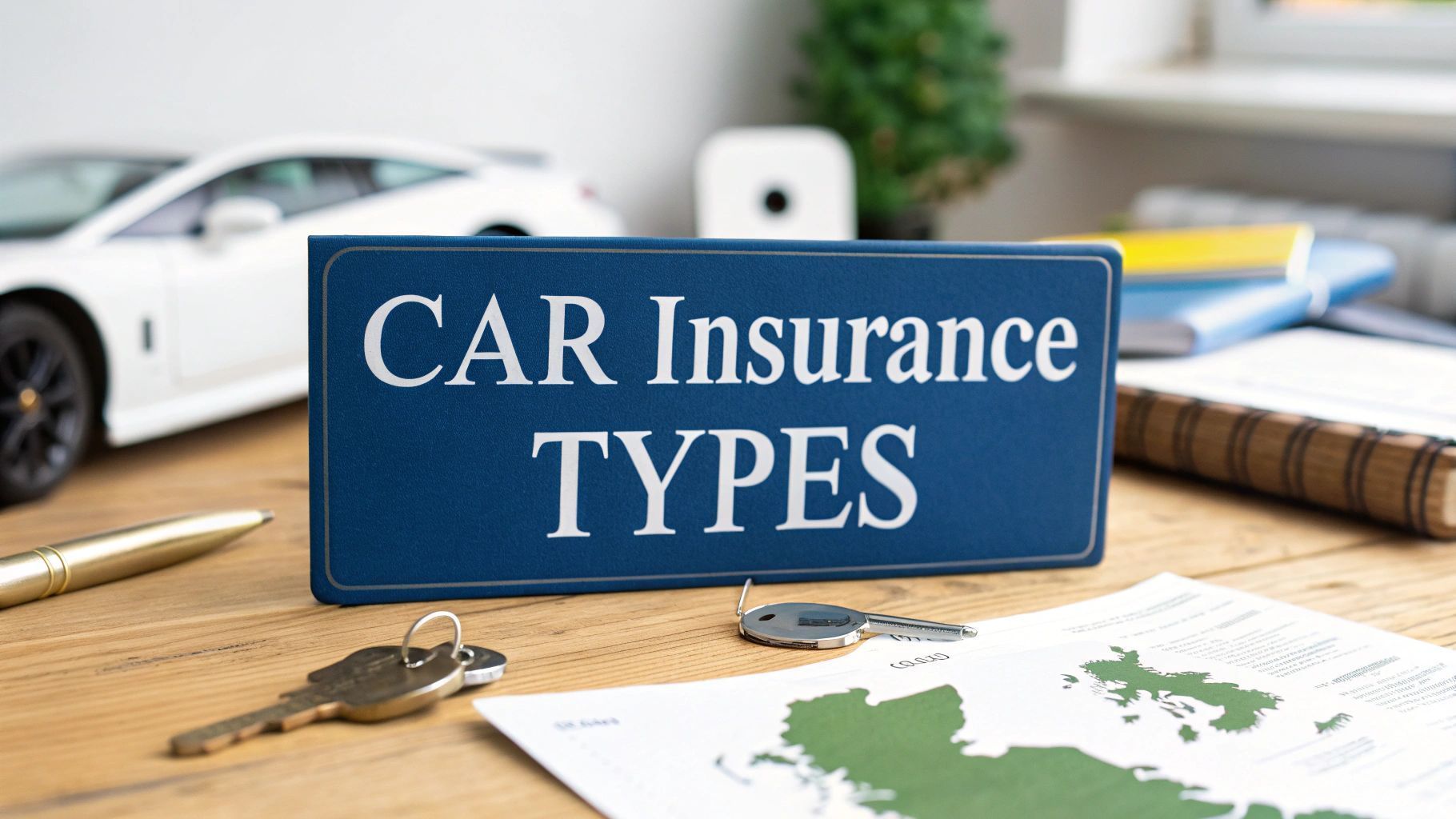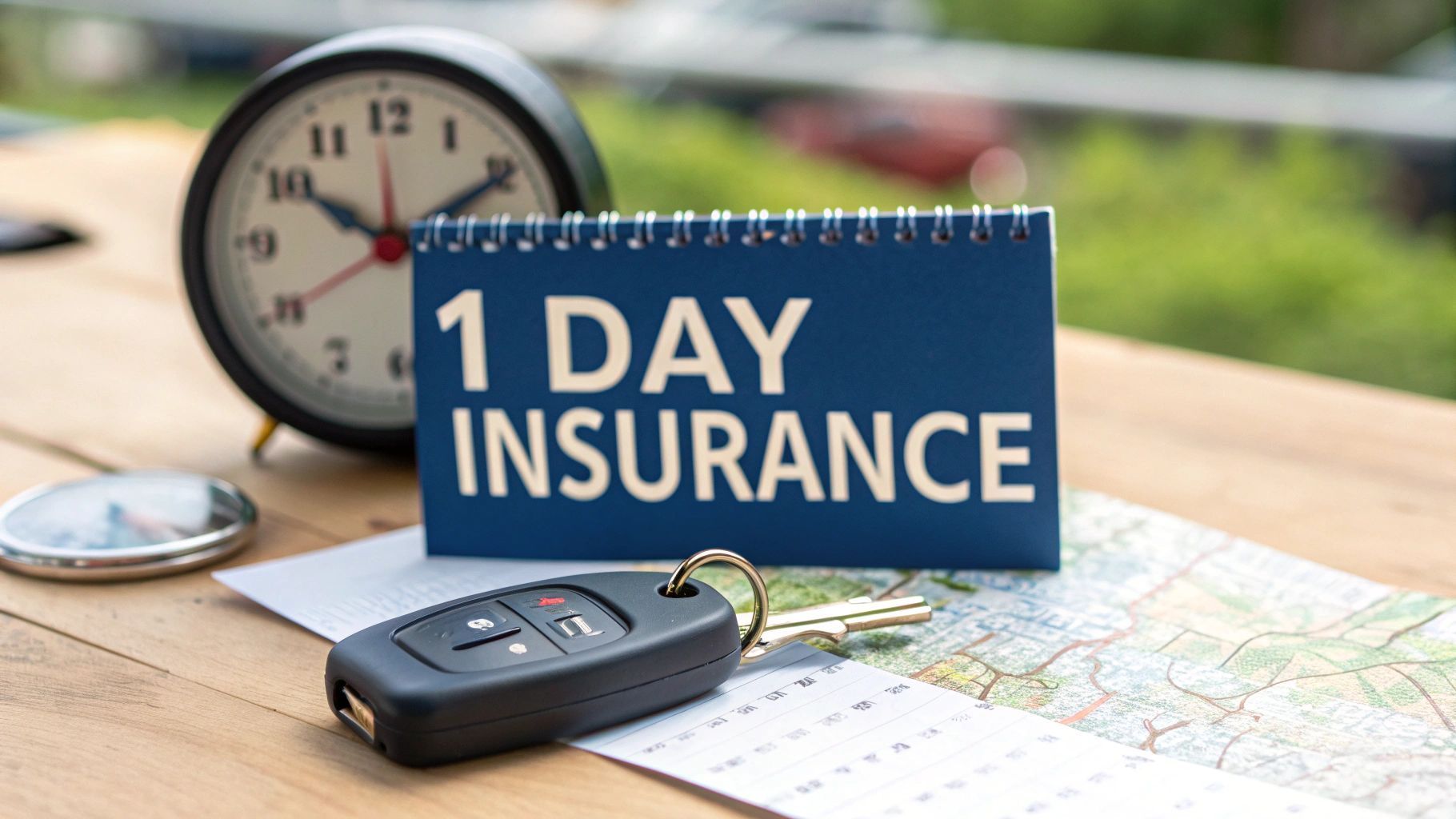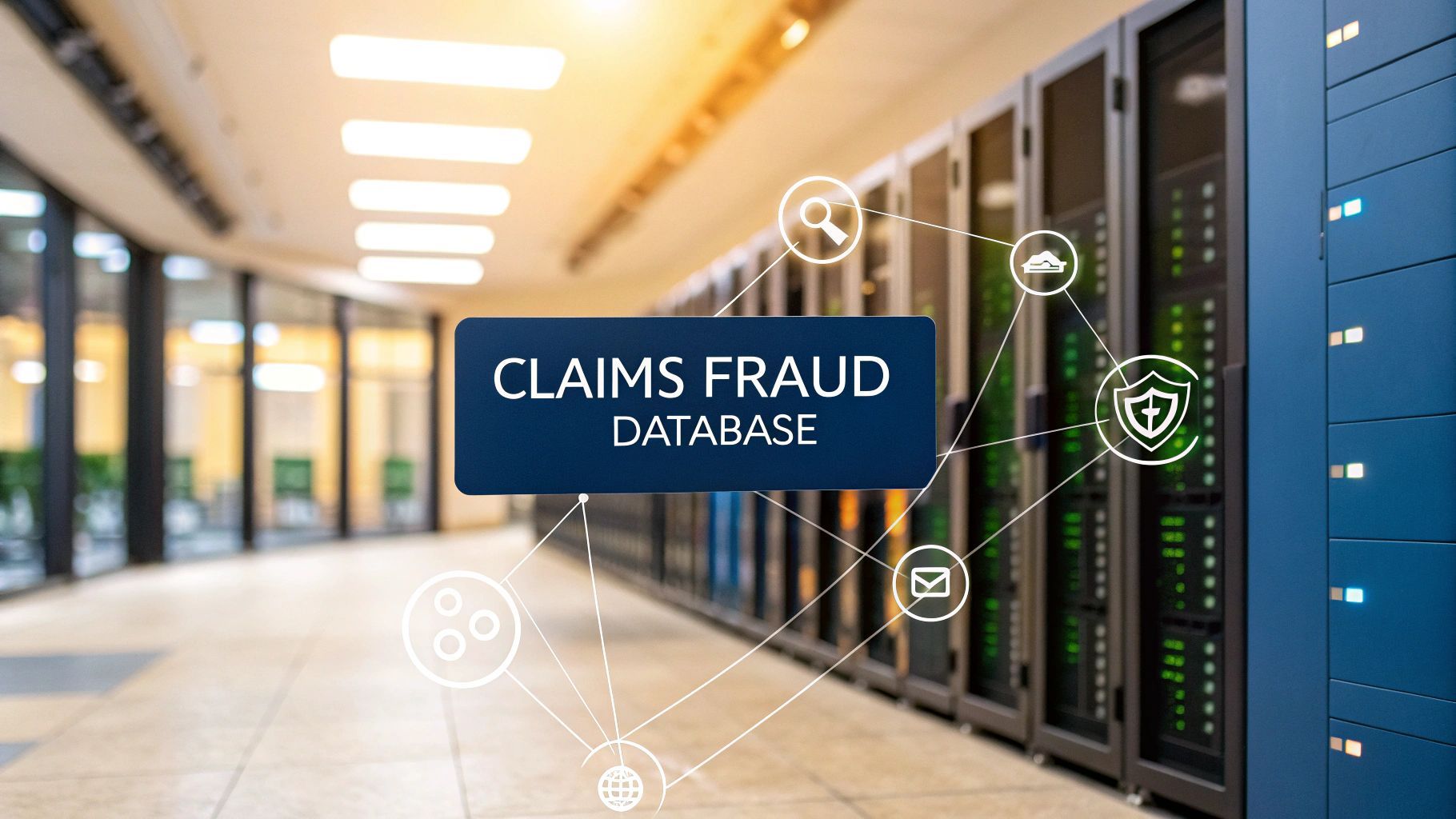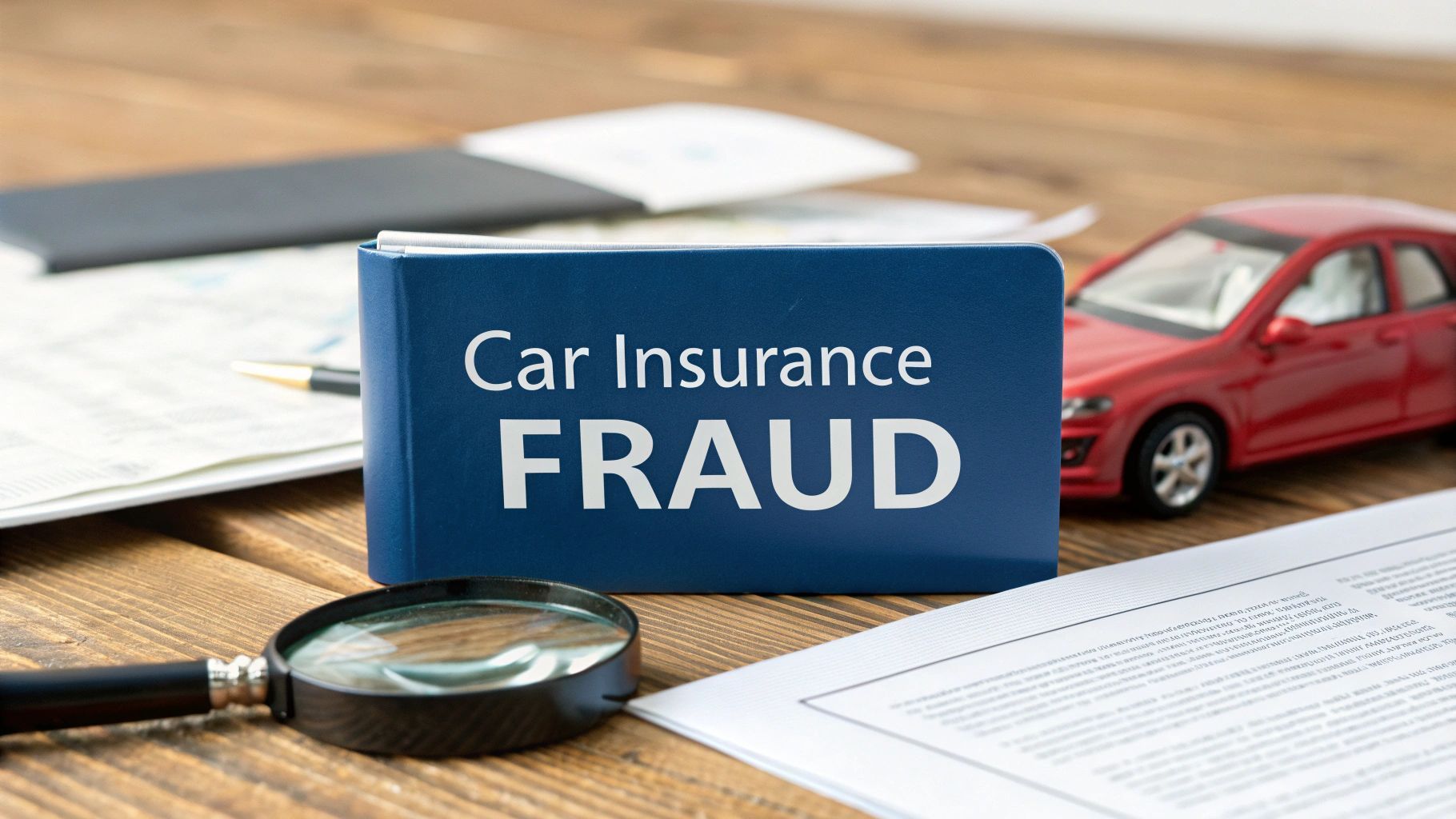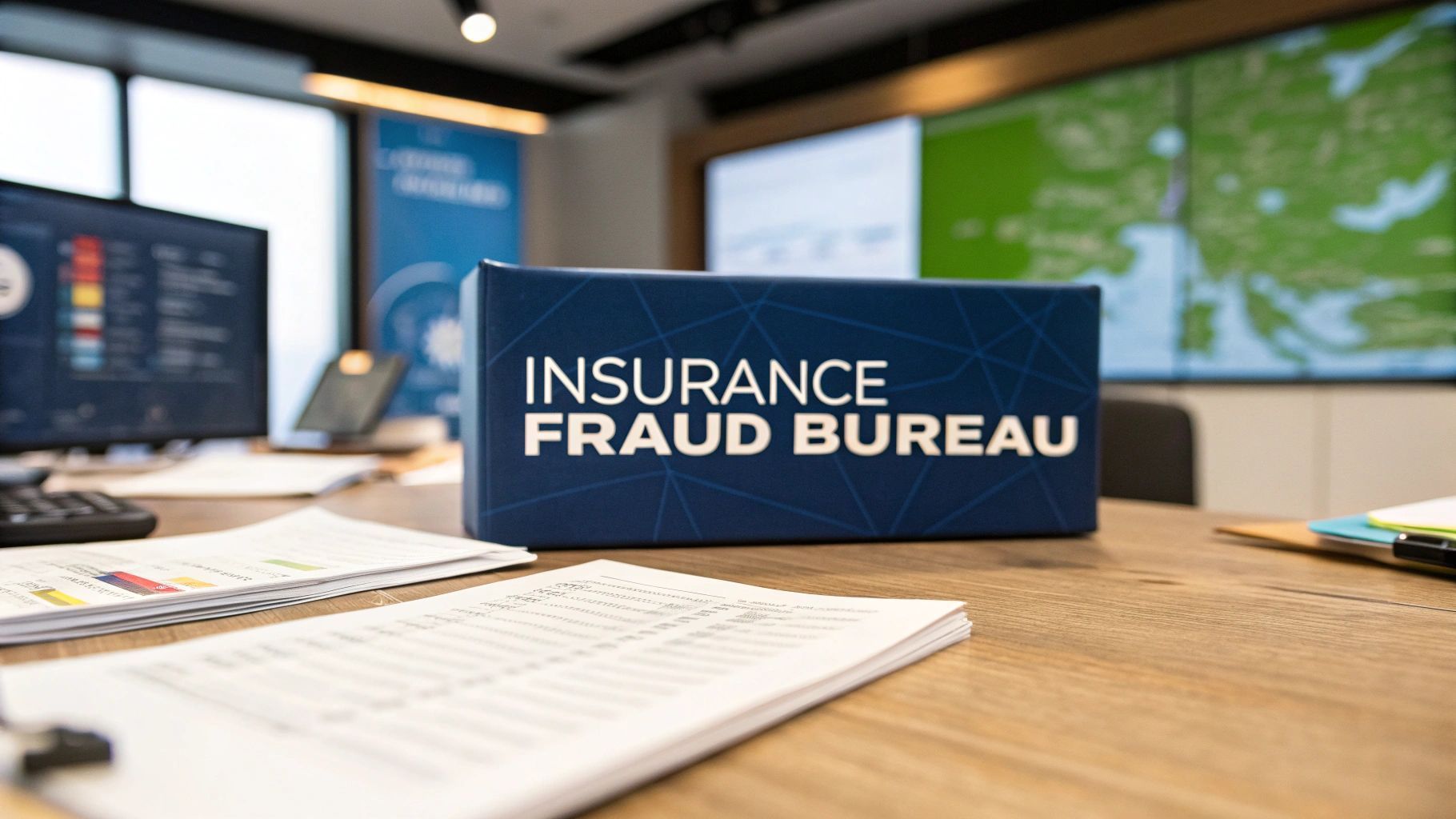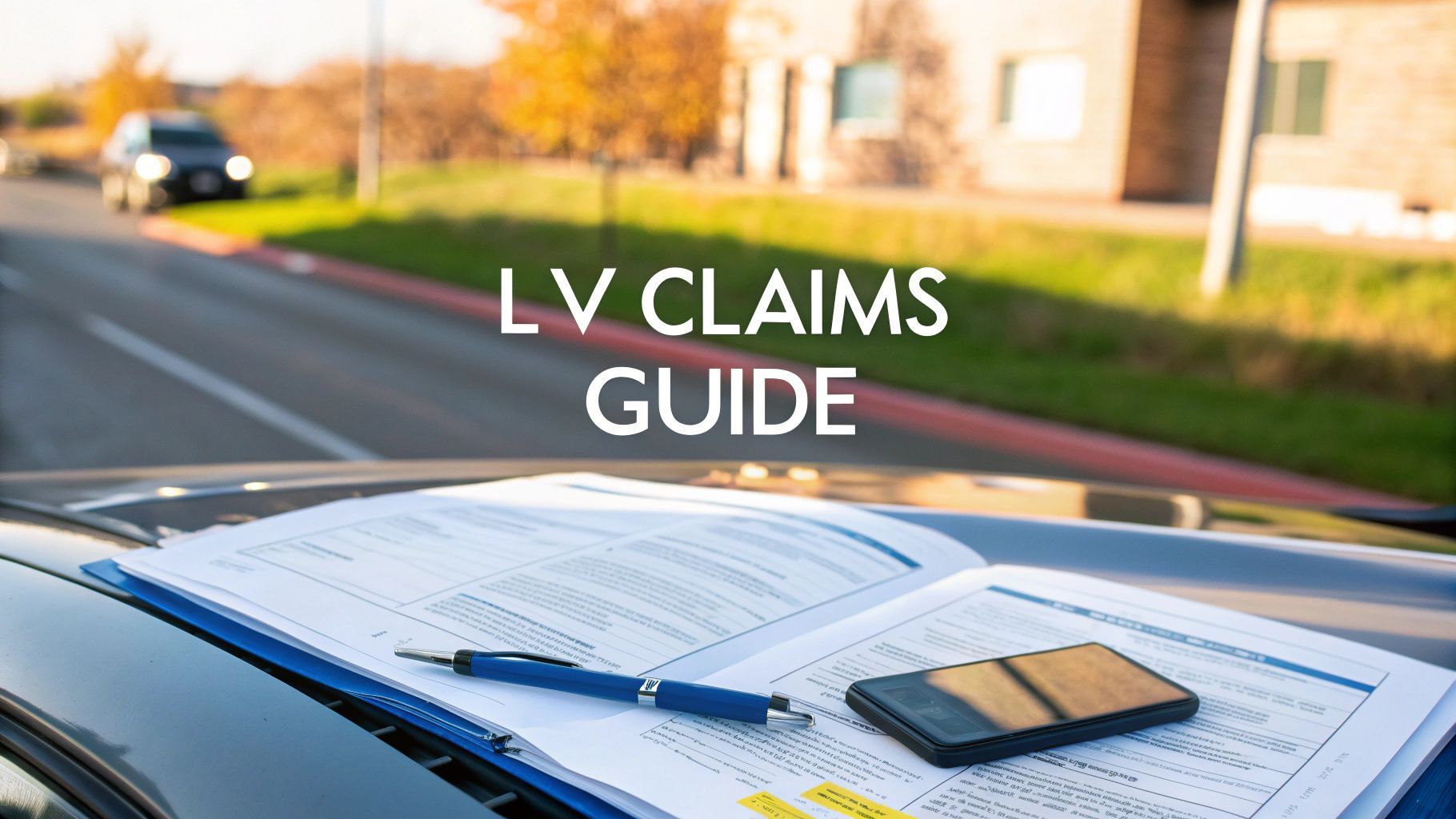What Does Comprehensive Car Insurance Cover in the UK
Let's unpack what "comprehensive" car insurance actually means in the real world. In short it’s the highest level of protection you can get for your vehicle in the UK.
It's your safety net for damage to your own car—even if you're the one at fault—as well as covering any damage to third parties plus fire and theft.
What Comprehensive Car Insurance Really Means
The word 'comprehensive' sounds like it covers everything under the sun doesn't it? But the reality has a few more layers. Getting your head around these different tiers of cover is the key to knowing what you’re actually paying for and what you can claim for when things go wrong.
Think of UK car insurance as having three main levels.
At the very bottom you have Third Party Only . This is the absolute legal minimum you need to be on the road. It only covers damage you cause to other people their vehicles or their property. If your own car gets damaged or stolen you're on your own—the repair bills are all yours.
Next up is Third Party Fire and Theft . This level includes everything from the Third Party policy but adds protection if your car is stolen or damaged in a fire. Crucially though it still won't cover repairs to your own car if you cause an accident.
Then you have the top tier: Comprehensive . This includes all the protection from the lower two levels and adds the most important piece of the puzzle—cover for accidental damage to your own vehicle no matter who was responsible.
This quick infographic breaks down how the different levels of cover stack up.
As you can see each level builds on the one before it giving you a wider and more robust safety net with comprehensive offering the most complete protection available.
To make this even clearer here's a quick side-by-side look at what each policy type typically covers.
UK Car Insurance Cover At a Glance
| Coverage Feature | Comprehensive | Third Party, Fire & Theft | Third Party Only |
|---|---|---|---|
| Injury to others | ✓ | ✓ | ✓ |
| Damage to other people's property | ✓ | ✓ | ✓ |
| Damage to your car by fire | ✓ | ✓ | ✗ |
| Your car being stolen | ✓ | ✓ | ✗ |
| Damage to your own car in an accident | ✓ | ✗ | ✗ |
| Windscreen damage | Often included | ✗ | ✗ |
| Personal belongings cover | Often included | ✗ | ✗ |
This table gives a general overview but it’s always a good idea to check the small print of your specific policy as details can vary between insurers.
The Importance of Provable Claims
Even with the best cover you can't just assume a payout is guaranteed. Your insurer will need you to prove your claim is legitimate and for good reason. The industry constantly battles insurance fraud from people exaggerating the extent of damage to those staging accidents deliberately.
This isn't just a problem for insurance companies; it ends up costing every honest driver.
Every fraudulent claim an insurer pays out adds to their overall losses. Those costs are then passed on to every single honest policyholder in the form of higher premiums. Fighting fraud is a shared responsibility that keeps insurance affordable for all of us.
So taking the time to understand exactly what your policy covers—and what evidence you'll need if you ever have to make a claim—is about more than just getting your money. It's about protecting the integrity of the whole insurance system and keeping costs down for everyone.
Understanding Your Core Protections
So what are you actually paying for when you get a comprehensive policy? At its heart this level of cover is designed to protect your own car against all sorts of real-world situations going way beyond just covering damage to other people. It’s the very thing that makes the policy truly "comprehensive."
The biggest piece of the puzzle is protection for accidental damage to your own car . Maybe you misjudged a tight spot in a car park and scraped a bollard or you were in a more serious collision that was your fault. This is the part of the policy that pays for your repairs. Without it you’d be footing the entire bill yourself.
Cover Beyond Collisions
But comprehensive insurance isn't just about crashes. It also acts as a vital safety net against crime and other unexpected events. This nearly always includes:
- Theft and Vandalism: If your car gets stolen or deliberately damaged—say someone keys the paintwork or smashes a window—your policy is there to cover the loss or the cost of repairs.
- Fire Damage: This protects you whether a fire is accidental like from an electrical fault or the result of an arson attack.
These protections are absolutely crucial. The financial hit of losing a car to theft or seeing it wrecked by vandals can be huge. A comprehensive policy makes sure you aren't left without a vehicle and facing a massive financial hole.
Everyday Protections and Added Benefits
What about the smaller day-to-day mishaps? Many comprehensive policies bundle in valuable extras that offer practical help right when you need it.

A common one is windscreen cover which often lets you get chips repaired or your windscreen replaced for a much lower excess than a standard claim would require. Another typical benefit is cover for personal belongings stolen from your car. There's usually a limit on the value though so it's always worth checking your policy documents to see what that is. Some policies even offer personal accident benefits which provide a payout if you're seriously injured.
In essence a comprehensive policy bundles together multiple layers of protection. From a minor prang to a major incident like theft or fire it is designed to get you back on the road with the least possible financial disruption.
It’s also interesting to see how premium costs are moving. As of mid-2025 the average annual premium in the UK is sitting around £757 . This is a significant 16% decrease from the previous year showing just how competitive the market is as insurers try to balance rising repair costs with the need to offer affordable cover.
Beyond the big-ticket items like damage and theft it pays to check if your policy covers smaller but still significant parts. For example it's worth finding out if you have car key replacement insurance because losing modern electronic keys can be a surprisingly expensive headache. The only way to know for sure what's included is to read the small print of your policy.
The Policy Exclusions That Can Invalidate Your Claim

Knowing what isn’t covered by your comprehensive policy is just as vital as knowing what is. Think of your policy as a contract with very specific conditions. Overlooking these can lead to the nightmare scenario: a rejected claim that leaves you footing the entire bill.
Insurers have a duty to ensure claims are legitimate. This isn't just about protecting their bottom line; it's about keeping premiums fair for everyone. Every fraudulent or invalid claim paid out contributes to the industry’s losses which eventually get passed on to honest policyholders through higher costs each year. This is why the provability of any claim is paramount.
So when you make a claim your insurer will carefully check that everything lines up with the terms you agreed to. It’s your responsibility to hold up your end of the bargain.
Common Reasons for a Rejected Claim
Some actions or circumstances can instantly invalidate your cover. These aren't buried in tiny print; they're fundamental conditions of your insurance agreement.
Here are a few of the most common exclusions:
- Undeclared Modifications: Have you fitted some flashy new alloy wheels or tweaked the engine for a bit more power? Any change that alters your car’s performance value or appearance must be declared . If you don't you risk voiding your policy.
- Incorrect Use: If you're using your personal car for business—like making deliveries or operating as a taxi—you need a specific business car insurance policy. A standard comprehensive policy won't cover any incidents that happen during commercial use.
- Lack of a Valid MOT: An MOT certificate is a legal requirement proving your vehicle is roadworthy. If you have an accident in a car without a valid MOT your insurer is almost certain to reject your claim.
These rules exist because they directly affect the risk an insurer is taking on. That undeclared engine upgrade might make your car more powerful and riskier to drive while those new alloys could make it a bigger target for thieves. The risk profile changes and your premium needs to reflect that.
Your policy is built on a principle called ' utmost good faith '. In simple terms it means you have to be completely honest and disclose all relevant facts. Hiding something even if it seems minor can be seen as misrepresentation and is a classic reason why an insurance company might refuse to pay a claim.
Understanding Wear and Tear vs. Damage
Another critical distinction to grasp is the difference between accidental damage (which is covered) and general 'wear and tear' (which is not). Your comprehensive policy is designed to protect you from unexpected events not to act as a warranty for your car's upkeep.
For instance if your engine fails due to old age or poor maintenance that's considered a mechanical breakdown and won’t be covered. The same goes for things like worn-out tyres a rusty exhaust or faded paintwork—these are all maintenance issues you're expected to manage yourself.
However if that same exhaust gets smashed because you reversed into a wall that's clear-cut accidental damage and a valid reason to claim. The key difference is a sudden unforeseen event .
The best advice? Read your policy documents with a critical eye. It's the only way to be sure your cover is watertight when you need it most.
Why Modern Car Repairs Drive Up Your Premiums

Ever wondered why your car insurance premium seems to climb even with a flawless driving record? The answer more often than not isn't about how you drive. It’s hidden under the bonnet and inside the bumper of today's cars.
Every claim an insurer pays out goes into a collective pot. When the cost of those claims goes up everyone’s premiums have to rise to cover it. This isn't just some abstract industry problem; it has a direct impact on your wallet. A minor bump that might have been a simple fix a decade ago can now trigger a surprisingly large repair bill all thanks to the complex tech packed into modern vehicles.
Insurers have no choice but to price this new reality into every policy they sell. The simple truth is that fixing a modern car is now a highly specialised—and very expensive—job.
The Technology Tax on Repairs
Today's cars are essentially computers on wheels. They're loaded with a dizzying network of sensors cameras and software systems designed to keep you safe on the road. This web of tech is collectively known as Advanced Driver Assistance Systems (ADAS) .
When a car with ADAS is in a collision the repair job is a world away from just hammering out a dent and applying a fresh coat of paint. Even replacing a windscreen can now involve the delicate recalibration of several crucial sensors.
- Complex Calibration: Just a slight knock can throw a lane-keeping camera or adaptive cruise control radar out of alignment. These systems need to be recalibrated to millimetre-perfect accuracy using specialist equipment which is both time-consuming and costly.
- Specialised Parts: Forget simple bulbs and easy-to-swap components. A damaged headlight today is often a sealed LED unit with its own built-in computer costing hundreds of pounds to replace.
- Technician Shortage: There’s a growing skills gap in the industry. Not enough technicians are trained to work on these high-tech systems and electric vehicles which naturally pushes labour costs higher.
The sheer sophistication of modern vehicles is a massive driver of claim costs. Every expensive repair whether it’s for a tiny sensor or a major component pushes up the total value of claims paid by insurers. That in turn gets reflected in the premiums for every single driver.
This is a key part of understanding what comprehensive car insurance covers and why the costs are what they are. To get a real sense of how these expenses add up just look at the costs associated with fixing complex components like parking sensors.
The Ripple Effect on Your Policy
This explosion in repair costs puts immense financial strain on the insurance industry. Recent figures from the Association of British Insurers (ABI) lay it bare. In the second quarter of 2025 alone their members paid out a staggering £3.1 billion in motor claims. A huge chunk of that was for repairs which jumped by £100 million in just three months to hit £2.1 billion .
This kind of financial pressure forces insurers to adjust premiums to cover the growing risk of a massive payout. It's a tricky balancing act. While all this new tech can help prevent accidents it also makes the ones that do happen far more expensive to put right.
The industry is actively exploring the role of technology in reducing insurance claims costs to find a way forward. But for now the price of your policy is a direct reflection of the shared cost of keeping Britain’s increasingly advanced cars safely on the road.
How Insurance Fraud Costs Every Honest Driver
Let's be clear: insurance fraud isn't a victimless crime. It’s a costly problem with a very real tangible impact on your wallet pushing up the price of every single comprehensive car insurance policy sold here in the UK.
When a criminal or simply a dishonest individual makes a fraudulent claim the losses for insurers are huge. These costs aren't just swallowed by the company; they get spread across the entire pool of honest policyholders. That means you me and every other law-abiding driver ends up paying more for cover to make up for the illegal activities of a dishonest few.
And this isn't just about big organised crime rings. While some scams are incredibly elaborate even seemingly small exaggerations on an otherwise genuine claim add to this shared financial burden impacting us all.
The Different Faces of Motoring Fraud
Insurance fraud wears many masks from opportunistic dishonesty on a small scale to highly calculated criminal operations. Getting to grips with what they look like is the first step to understanding the scale of the problem and its cost to the industry.
Common types of fraud include:
- Exaggerating Claims: This happens when someone with a legitimate claim decides to inflate the extent of the damage or loss. Think adding pre-existing scratches to a repair list after a minor bump or claiming for expensive personal items that were never actually in the car when it was stolen.
- Fabricated Incidents: This is where a person claims for an accident theft or damage that never even happened. They might get rid of a vehicle themselves and then report it stolen just to get an insurance payout.
- 'Crash for Cash' Scams: These are dangerous premeditated collisions deliberately caused by criminals to make fraudulent personal injury claims. Organised gangs often target innocent motorists putting lives at risk for financial gain. You can learn more about how to spot the persistent threat of crash for cash scams and protect yourself.
Each of these acts adds to the total cost of claims which insurers then have no choice but to factor into their pricing models for everyone. The industry loses billions each year to fraud a cost that is ultimately passed directly to the consumer.
How Insurers Prove Fraud and Protect Honest Drivers
Insurers aren't just sitting back and letting this happen. They invest heavily in sophisticated systems and specialist teams dedicated to sniffing out and proving fraudulent activity all to protect their honest customers. It's a critical part of ensuring that what comprehensive car insurance covers remains affordable for the majority.
Insurers use a combination of advanced data analytics forensic investigations and cross-industry intelligence sharing to identify suspicious patterns. Every claim is scrutinised for inconsistencies to ensure its provability and legitimacy.
Investigators are trained to look for red flags. These might be conflicting accounts of an incident a history of frequent claims from one person or physical evidence where the damage just doesn't match the story of the accident. By rooting out fraud they help maintain the integrity of the whole system and stop honest drivers from footing the bill for criminals. The battle against fraud is a collective effort that ultimately benefits every policyholder by keeping premiums as low as they can be.
Navigating a Claim After an Accident
An accident is stressful enough without the added headache of a complicated insurance claim. But knowing the right steps to take in the immediate aftermath is the single best way to make sure your claim is provable and gets processed without any frustrating delays.
Your first priority is always safety. But once everyone is safe your focus needs to switch to gathering evidence. Grab your phone and take clear photos of the entire scene—capture the positions of the vehicles any visible damage to all cars involved and even the road conditions. These images create an impartial record of what happened that becomes incredibly difficult to dispute later.
You'll also need to exchange details with the other driver. It’s crucial not to admit fault at the scene but make sure you get their name address phone number and insurance information. This is the foundation of your claim.
Managing Modern Repair Challenges
Getting your car repaired isn’t as straightforward as it used to be. The sheer amount of technology packed into modern vehicles has introduced new challenges that have a direct impact on how your comprehensive cover actually works.
The UK car insurance market is being reshaped by these tech advancements. For example the widespread use of Advanced Driver Assistance Systems (ADAS) means even a minor bump can result in eye-watering repair bills. These sensitive systems need specialist recalibration to function correctly a job that can only be done at insurer-approved garages with the right high-tech equipment.
It's a similar story with electric vehicles (EVs). A damaged battery can be a massive new cost sometimes leading to a complete write-off simply because a repair is too expensive. These factors push up claim costs and in turn the premiums we all pay. You can discover more insights about the challenges in the UK car insurance market on wecovr.com.
A vehicle is typically declared a 'write-off' or total loss when the cost to repair it safely and correctly exceeds its market value. Your insurer will pay out the car's current worth minus your excess.
Understanding this process helps you set realistic expectations. Your comprehensive policy is designed to cover these costs but the final call on whether to repair or write off the vehicle rests with the insurer. Their decision will be based on a professional assessment of the damage and the projected repair expenses. This ensures claims are managed sustainably which ultimately helps keep insurance affordable for everyone.
Got Questions? We’ve Got Answers
When you start digging into the details of comprehensive car insurance it’s only natural for questions to pop up. Let's tackle some of the most common ones that drivers ask so you can feel more confident about your cover.
Is Comprehensive Always the Most Expensive Option?
You'd think so wouldn't you? But surprisingly not always. Insurers use complex calculations to figure out who's a risk and sometimes drivers who opt for the bare minimum third-party cover are seen as more of a gamble.
It sounds counterintuitive but it means that a comprehensive policy can occasionally work out cheaper. The golden rule? Always get quotes for all levels of cover before making a decision.
Can I Drive Other Cars on My Policy?
This used to be a pretty standard perk but it’s become much less common in recent years. If your policy does allow you to drive other cars—often called a 'Driving Other Cars' (DOC) extension—it will be spelled out clearly in your policy documents.
Even then it typically only gives you basic third-party liability. Never ever just assume you have this cover. Always check the fine print first.
How Does a No-Claims Bonus Work?
Think of it as a reward for being a safe driver. For every year you go without making a claim your insurer gives you a discount on your premium. This is your no-claims bonus (NCB) .
However if you need to make a fault claim on your comprehensive policy you'll usually see your NCB reduced or even wiped out entirely. The only way around this is if you've paid a bit extra for no-claims bonus protection .
Am I Covered for Driving in Europe?
Most UK comprehensive policies will give you the absolute minimum legal third-party cover you need to drive in the EU. But that’s it—your full comprehensive protection for things like theft or damage doesn't automatically come with you.
To get the same level of cover abroad you’ll almost always need to tell your insurer about your trip. They might charge an extra fee for it so be sure to get it sorted before you set off.
At Proova , we give you the tools to document your assets before anything goes wrong. This makes sure your claims are backed by solid proof and can be sorted out quickly. Secure your peace of mind and make insurance simpler by visiting https://www.proova.com.




